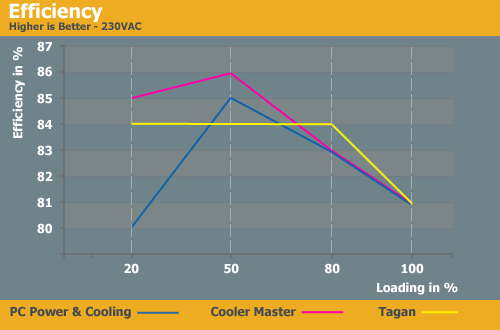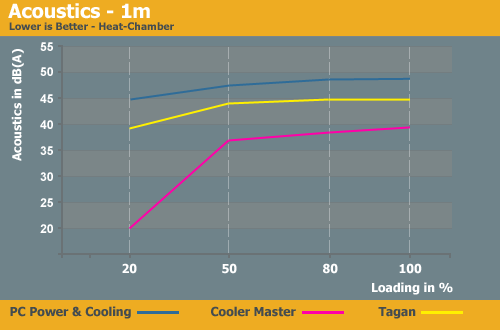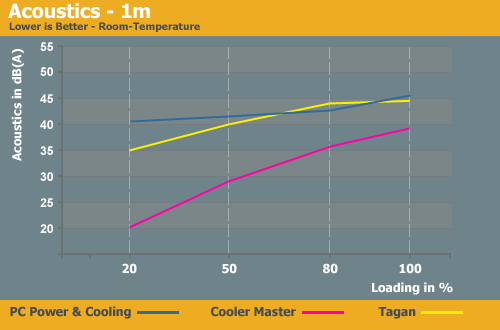Ultra High-End PSU Roundup
by Christoph Katzer on October 22, 2007 6:00 AM EST- Posted in
- Cases/Cooling/PSUs
Comparison and Conclusion
We have seen three totally different approaches to strong power supplies from the technology side today. PC Power & Cooling is using one fan and has in fact two separate power supplies in one chassis. We have already written about the disadvantages about this topology and when we compare the efficiency and noise later we will not see real advantages. Cooler Master is buying a very good basic design, and many other companies are using this design as well. There is little that can go wrong when buying from Enhance and the results show that. Finally, we have Tagan whose layout is a very good enhancement of the first revision and it shows almost no flaws in the performance.

From the appearance all power supplies make a very good stand and from the cable point of view they are all similar. The lengths are decent and the choice of connectors is also good. The Turbo Cool at 1200W is the lowest wattage unit on the field today, and it also has the fewest number of SATA and Molex connectors. We think that with 1200W you might want to have more connectors to choose from and not only six SATA and eight Molex - a few more would have been appreciated. Cooler Master is not looking too much better and has just two SATA connectors more and even one Molex less, but they do offer more PEG connectors. Tagan is top of the class you in this area with 12 SATA connectors, all of a decent length. All three power supplies have a decent amount of graphics card connectors and with these and it's hard to imagine anybody will have a problem.

The efficiency levels are good with all the models we have seen today. Cooler Master has slightly better results with lower and medium loads than the other two and Tagan keeps up its efficiency from 84% with 230VAC over the complete time of loading between 20 and 80%. With 86% Cooler Master leads the pack until beyond the half-way point in the "race", but overall the power supplies all performed well and there is nothing to complain about.


As we have mentioned before if you really want to have a 1000W+ power supply you cannot expect it to be quiet - especially not at full load. 1000W produced in the power supply leaves a lot of heat and this heat needs to be exhausted (unless you're planning on frying eggs inside your computer). This can only be done with a very good design layout and a decent fan. PC Power & Cooling clearly isn't the most elegant approach, instead opting for brute force in order to provide adequate airflow. The fan needs to be strong to reach around all the small corners where hot air could hide, and this creates a lot of noise. Cooler Master has a better approach with a 12cm fan that is just pushing enough air into the power supply to cool all of the components. The fins of the heat sinks are thick but with enough space between them that air can reach even to the PCB. In terms of intelligent cooling we have to admit that Tagan also has a very nice design which serves its purposes. Unfortunately, here we again have a very noisy fan which will probably wake the neighbors.
The DC outputs were good except for the Tagan ITZ which showed a view flaws. The voltage regulation functions very well, and even at the highest loads and with 10% overloading the three units stand their ground. In case of ripple and noise, we saw flaws with the Tagan ITZ where we measured fluctuations of up to 130mV on the 12V rail and quite high ripple at the 3.3V rail as well. PC Power & Cooling has not more than 12mV to show which is a very good result.
Pricing is a bit odd than the air, as two of the power supplies are not out yet. The Tagan ITZ with 1300W is already available for $399 USD and will not be available in the European market. Maxpoint told us they are working on European products which will have a different name when they are finally released. PCP&C will launch the Turbo Cool with 1200W for $499 USD and the release will be shortly. Cooler Master will launch their Real Power Pro for around $370 USD in the market. The European prices for these two products are not yet decided but the rough exchange rates for both of the models are 260 EUR for the Real Power Pro and the PCP&C Turbo Cool will be around 350 EUR at actual exchange rates. These prices make both the Tagan and Cooler Master a bargain since the prices will still surely fall during the first week of release.
Having seen these three power supplies now we can't really come up with a real suggestion which one to buy. All of them managed to deliver the rated power and even a little bit more. In the end the user has to decide which one will best fit their needs, although perhaps the more pertinent question to ask here is if there is really a need for huge power supplies like this at all? Just as not everyone needs quad-core processors, multiple graphics cards, extreme overclocking, and/or a dozen hard drives running in multiple RAID arrays, there are plenty of computer users that will likely never need anything near 1000W of power for their home computer.
We have seen three totally different approaches to strong power supplies from the technology side today. PC Power & Cooling is using one fan and has in fact two separate power supplies in one chassis. We have already written about the disadvantages about this topology and when we compare the efficiency and noise later we will not see real advantages. Cooler Master is buying a very good basic design, and many other companies are using this design as well. There is little that can go wrong when buying from Enhance and the results show that. Finally, we have Tagan whose layout is a very good enhancement of the first revision and it shows almost no flaws in the performance.

From the appearance all power supplies make a very good stand and from the cable point of view they are all similar. The lengths are decent and the choice of connectors is also good. The Turbo Cool at 1200W is the lowest wattage unit on the field today, and it also has the fewest number of SATA and Molex connectors. We think that with 1200W you might want to have more connectors to choose from and not only six SATA and eight Molex - a few more would have been appreciated. Cooler Master is not looking too much better and has just two SATA connectors more and even one Molex less, but they do offer more PEG connectors. Tagan is top of the class you in this area with 12 SATA connectors, all of a decent length. All three power supplies have a decent amount of graphics card connectors and with these and it's hard to imagine anybody will have a problem.

The efficiency levels are good with all the models we have seen today. Cooler Master has slightly better results with lower and medium loads than the other two and Tagan keeps up its efficiency from 84% with 230VAC over the complete time of loading between 20 and 80%. With 86% Cooler Master leads the pack until beyond the half-way point in the "race", but overall the power supplies all performed well and there is nothing to complain about.


As we have mentioned before if you really want to have a 1000W+ power supply you cannot expect it to be quiet - especially not at full load. 1000W produced in the power supply leaves a lot of heat and this heat needs to be exhausted (unless you're planning on frying eggs inside your computer). This can only be done with a very good design layout and a decent fan. PC Power & Cooling clearly isn't the most elegant approach, instead opting for brute force in order to provide adequate airflow. The fan needs to be strong to reach around all the small corners where hot air could hide, and this creates a lot of noise. Cooler Master has a better approach with a 12cm fan that is just pushing enough air into the power supply to cool all of the components. The fins of the heat sinks are thick but with enough space between them that air can reach even to the PCB. In terms of intelligent cooling we have to admit that Tagan also has a very nice design which serves its purposes. Unfortunately, here we again have a very noisy fan which will probably wake the neighbors.
The DC outputs were good except for the Tagan ITZ which showed a view flaws. The voltage regulation functions very well, and even at the highest loads and with 10% overloading the three units stand their ground. In case of ripple and noise, we saw flaws with the Tagan ITZ where we measured fluctuations of up to 130mV on the 12V rail and quite high ripple at the 3.3V rail as well. PC Power & Cooling has not more than 12mV to show which is a very good result.
Pricing is a bit odd than the air, as two of the power supplies are not out yet. The Tagan ITZ with 1300W is already available for $399 USD and will not be available in the European market. Maxpoint told us they are working on European products which will have a different name when they are finally released. PCP&C will launch the Turbo Cool with 1200W for $499 USD and the release will be shortly. Cooler Master will launch their Real Power Pro for around $370 USD in the market. The European prices for these two products are not yet decided but the rough exchange rates for both of the models are 260 EUR for the Real Power Pro and the PCP&C Turbo Cool will be around 350 EUR at actual exchange rates. These prices make both the Tagan and Cooler Master a bargain since the prices will still surely fall during the first week of release.
Having seen these three power supplies now we can't really come up with a real suggestion which one to buy. All of them managed to deliver the rated power and even a little bit more. In the end the user has to decide which one will best fit their needs, although perhaps the more pertinent question to ask here is if there is really a need for huge power supplies like this at all? Just as not everyone needs quad-core processors, multiple graphics cards, extreme overclocking, and/or a dozen hard drives running in multiple RAID arrays, there are plenty of computer users that will likely never need anything near 1000W of power for their home computer.










27 Comments
View All Comments
redly1 - Monday, October 22, 2007 - link
I'm just trying to imagine the flames that ensue when something goes bad on the motherboard.Anyone ever burn up a classic Athlon by forgetting to put the heatsink on? Imagine doing that with a 1.3kW supply? Yikes
billa16 - Tuesday, October 23, 2007 - link
I did that on a k7@950. I was trying to oc it(hardmod with a pencil). Nothing happend the first 2 times(just a few secs). After that it's stopped working. No sparks/flames and stuff like that. Don't belive anything U read/see on the internet.This type of power supply's have protections. If something is damaged so bad that would cause flames the protection kicks in. The worst fire scenario with this type of PSU will be a flash when the fuse burns out.
Sorry for my poor english.
DigitalFreak - Monday, October 22, 2007 - link
Still amazes me how many people fall for the marketing hype...Traciatim - Monday, October 22, 2007 - link
Instead of just giving specs and doing an overview of the efficiency, why not design a machine that actually needs these over say a 600-700Watt PSU and show watt you would need to do do actually use one of these.I have a pretty small machine, and it regularly pulls 120Watts out of the wall, 200Watts if I Get everything ramped up. I'm also using a P4, not a Core2Duo so it's not going to be as efficient.
The ONLY point that I can see to have one of these is simply to waste money on uneeded equipment that could be better spent one something performance based and to say that 'My PSU is bigger than your PSU'.
retrospooty - Monday, October 22, 2007 - link
Ya, these 1000+ watt PSU's are marketed to enthusiests, and are supposed to be for heavily overclocked quad core CPU's (meaning cascade, dry ICE or liquid nitrogen cooling kind of overclocks) with overclocked high end SLI or crossfire rigs, and plenty of hard drives and other peripherals added as well. We are talking $3000 or higher systems - WAY overkill probably even for that purpose.JarredWalton - Monday, October 22, 2007 - link
You can see the most power-hungry system I've personally tested http://www.anandtech.com/systems/showdoc.aspx?i=30...">right here - which uses standard ATX components and a Topower PSU. That's a lot more system than most people run, obviously, but if maximum efficiency is achieved in the 40-80% load range, and if that particular PSU was around 80% efficient, it was outputting around 600W of power at maximum load.Toss in TriFire HD 2900 XT and you could add another 100W to that, maybe. If you were to get an overclocked Xeon platform with dual quad-core CPUs plus CrossFire/TriFire, you could actually reach the point where 1300W was "required". LOL
ORB chasers and "professional benchmarkers" running at insane overclocks (i.e. 5000 MHz quad-core) deal with exponential power requirement increases as well. The solution is either to use multiple PSUs or else get one of these uber-powerful designs. So these appear to be for around 0.01% of the market, I guess?
Michael91ah - Monday, October 22, 2007 - link
Glad to see the statistics for these 3 units. I really like the Cooler Master's curve on the acoustics. That noise makes a big difference for me when choosing a power supply.